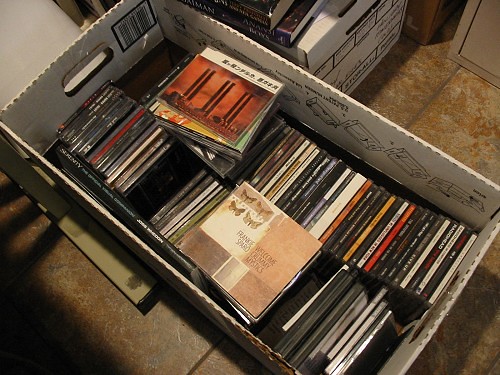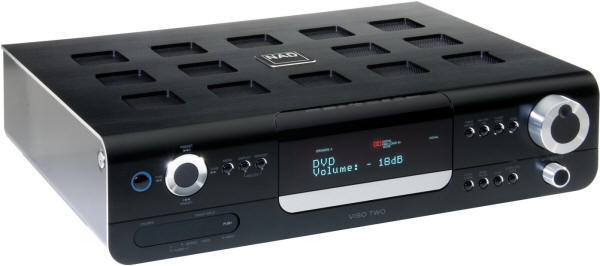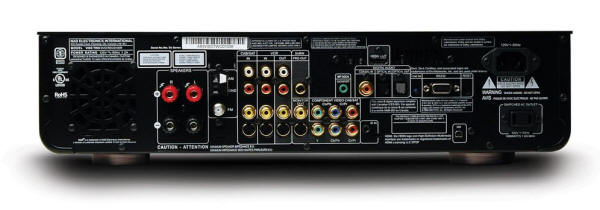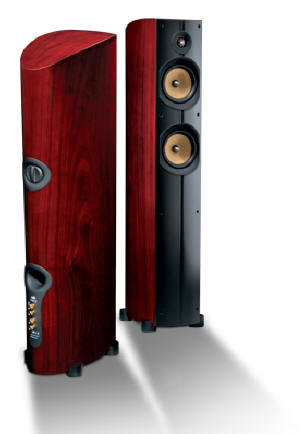|
You are reading the older HTML site Positive Feedback ISSUE 41january/february 2009
The Neoteric Listener
...listens to NAD's Viso Two and PSB's Imagine T
loudspeakers... a perfect match!
Thunk! For hours, the sound of compact discs being tossed into a cardboard box acts as a surprisingly accurate time clock for my shifts at the record store. Thunk! As the stack grew higher, I know that my time fending off contentious drunks ("Pat Travers can kick Jimmy Page's ass any time") and ringing up Iron Maiden EP's will soon be over. Thunk, Thunk! Depending on personal whim and the album cover (any band that listed their hairdresser on the credits is summarily discarded), each disc is given twenty seconds to justify lifetimes of practicing, playing endless gigs at smelly, squalid bars, and weaseling hard-earned money from indulgent family members. Music corporations reluctantly shell out a Prince's ransom in recording time and novelty buttons, while an anonymous (until now), no-talent clerk superciliously dismisses the recording in less time than it takes to say, "This sucks." Comes with the territory, of course, and, to quote Keith Richards, "That's big time rock n' roll." Most of the stuff that comes in is a music piñata of the highest order: weepy confessionals, fidgety pop ephemera, or the perennial pariah competition between Goth, punk, and metal. Quality, like beauty, transcends genre, so you cherry pick the best, sell the rest. Naturally, some bands make it to the second cut, some make it to in-store rotation, and a fractional sum are recommended and sold to everyone who asked, "Anything new, anything good?" Admittedly, it is a hit or miss process, and there are occasional gaffes, such as the time when I sneeringly dismiss one track as "too slow," only to replay it later and realize that I am the one who is too slow. Does Sinead O'Connor's cover of "Nothing Compares 2 You" ring any bells?
You would think that my past experience in the record shop would teach me to avoid snap judgments, but not at all! I enjoy learning new things over and over, which explains my propensity to fall into the trap of "Tom, I can name the quality of that audio system in five notes." To be fair, some audio components sound as weak as the insipid emo bands I tossed into the dumpster. To be fairer, however, most of the products reviewed in PFO require a great deal of time and attention to ascertain the relative merits and insufficiencies of the gear (and offset the permanent demerits and inadequacies of the reviewer). Most manufacturers either know personally or employ individuals who possess a thorough understanding of the engineering and sonic signature of superior audio products. When something sounds the way it does, it's usually by choice, not because they didn't know how to make it sound like X, Y, or Z. My uncanny ability to make evaluations lightning fast and lightning wrong struck again when I first received the newest system package for review, the NAD Viso Two DVD/CD receiver ($1299) and a pair of PSB Imagine T Tower loudspeakers ($2000 a pair). I've always been a bit quick and a bit thick, so I was especially pleased by how easy it is to get this system humming. My simple AV set up of set-top box and TV are easily accommodated by the NAD Two's coaxial and composite jacks, and it only took about ten minutes total set up time before I was enjoying a superb playback of George C. Scott's martial monolog in Patton. Americans may not love a war, but they do want their war movies to look and sound good, by jingo, and this version of the gravel voiced general commanded my full attention. Clearly, the DVD picture and sound seemed promising. Congratulating myself on being able to follow directions (or at least not lose the manual), I loaded a CD and turned my attention to the PSB's. Beautifully styled in "cathedral" matched wood veneers and elegant, curvilinear lines, the visual presentation of these speakers immediately made a wonderful first impression in my listening room. They're not so big that you would need an actual cathedral to house them, and everyone who saw them in my home commented on how attractive they were simply as furniture.
And the sound...? Did I mention that the look of these speakers made a wonderful first-impression in my listening room? It's not that the Imagine T's sounded bad, exactly, but their beguiling beauty made me anticipate some earth-shattering revelation from within (not the first time I've been hornswoggled by that expectation, by the way). But their detail didn't leave a dueling scar, nor could you fit Ben Hur in their soundstage, and me timbers definitely weren't shivering. Almost a full minute of my valuable time and heightened optimism, squandered! Still, they don't pay me a beggar's pay in PFO script to give up at first blush, so I gave up, and used the well laid out, backlit remote control to activate the Viso Two's tuner. Very satisfactory! After taking a moment to establish the presets, I churned through each station and was rewarded with a strong, clear signal, boasting a very pleasing sound. Because of the horrendously poor radio reception in my area, I've learned to accept the "Hey, is that a blender in the background?" quality of radio in my home. The Viso Two significantly reduced the static, without reducing the headroom to mineshaft levels. Moving from station to station, the PSB's started to open up nicely. Or maybe I nicely opened up to the PSB's, but I definitely began to appreciate the scope and scale of the music flowing from the Imagine T's. For most of the evening, I listened to the local university classical music station, and paid attention to how well the PSB's could deliver the wallop of kettle drums, the slurring of ascending thirty-second notes on violins, and the skunk-scattering vocal racket, err, rapture of the coloratura soprano. The NAD/PSB combination presented all instruments in an admirably balanced, realistic manner. What I mistook for a lack of definition on the high or low end of the frequency range is actually the absence of an artificial boost at either extreme. Too often, what people (and by people, I mean me) are captivated by in a speaker's sound is the sssing of a cymbal's edge or the boomp of a kick drum, when neither of those were supposed to be thrust out front and center. The PSB's avoid such showroom tricks and offer, instead, a mature sound that continues to charm the listener over time, and with a variety of material. The next few weeks were almost completely focused on the Viso Two/Imagine T's as an audio product. Naturally, I continued to monkey about with the DVD player, playing scenes and watching a few movies, but the pleasure derived from playing old and new favorites proved irresistible.
I once saw a reputable audio dealer buzz-kill a group of spellbound listeners by more than half-jokingly exclaim, ""Tell me you're not listening to Neil Young on this superb music system!" Cultivating a more discerning taste is one thing, chiding potential customers, quite another. In tribute to those who have been scolded before, I always start my evaluations by playing music that billions of people could whistle underwater. You don't pay hard-earned cash to buy audio gear that forces you to pull the curtains whenever you play your music. Granted, there are times when you play things not because they sound good, but because it sounds good, but I hate the clichéd analogy that you don't drive your Ferrari to do your shopping. If I had a Ferrari, I'd drive it to the ground going back and forth to Costco, and leave a trail of parts in my wake ("On your mark, get set, gauche!"). Rebelling against elitism by embracing the mainstream is hardly my invention, of course, but it does give me the pretext to cue up "Getting Better" from Sgt. Peppers Lonely Hearts Club Band. The Viso Two deftly conveyed the song's opening chords: bright, driving, but not shrill. Similarly, Paul McCartney's melodic bass line running throughout the song rarely fades in the mix (as it does to a degree with my Arcam CD82). On "Being for The Benefit of Mr. Kite," John Lennon's iconic vocals were warm, clear, nasally, and naturally; the Viso Two had no problem keeping up with all the song's headphone parlor games (hard pans, whirling calliopes, shimmering high-hats played backwards, etc.). NAD and PSB guaranteed a splendid time for all. The Viso Two doesn't have a phono stage, so my Japanese translucent red vinyl of this album will have to wait.
Deciding that I'm not the rocker I've convinced myself I used to be, I put on the Ditty Bops Moon Over the Freeway. This album, a cabaret collection of western swing, ragtime, and folk, is destined to become an audiophile staple (not because it's recorded so pristinely, but because it's so much fun to listen to on a good system), so enjoy it now before others make you sick of it. On the title track, the individual character of each instrument played during the solo (electric guitar, acoustic guitar, and violin) was reproduced magnificently. Vocal harmonies, so essential to the charm of this recording, are blended together sweetly and distinctly in a deep, but not artificially expansive, soundstage. Ok, so this album makes most every system sound good, but on seminal bluesman Buddy Guy's "When My Left Eye Jumps" the Viso Two and Imagine T's were even able to coax a thoroughly enjoyable sound from a shockingly poor compact disc. Unlike the marvelous tone of Guy's guitar on the vinyl version of this song, the CD version makes you grab for your oil of cloves. Somehow, this system roughed it out so that the tone was just on the edge of being painfully bright. A feat not likely to end up on the page of a PSB ad, but if it can handle this CD, it can handle all my other Redbook ruffians. Just to make sure, I put on Guided by Voices "I Am a Tree," a song whose notes are recorded well, but still piercing, and found that they were delivered as music, and not missiles. So the NAD/PSB sound good, but don't I get the picture? I've learned that, for most people, a system like this should be primarily evaluated for the music performance because, quite simply, TV is easy. Most TV's sound like they're blasting noise from a walkie-talkie. Almost anything is an improvement. That being said, many (many!) refuse to look at any AV/speaker set up that can't be charted in an excel formula. The NAD box doesn't allow for a 5.1 configuration, and pictures are upscaled to 1080i only. I say "only" because many people view 7.1 and 1080p as the ultimate arbiter of quality, and boot two channel and interlaced pictures down the sliding scale. In my experience, many "pinnacle of performance" audio visual setups should be consigned to the oblivion created for poorly designed subwoofers, factory TV settings, and 3D high definition television. The effect is fun at first, but wears mighty thin, mighty fast. I prefer two channel or 2.1 when watching films because I don't like cars backfiring behind my head, or ambient crowd noise milling about the sidewalls. Reasonable people agreeing to disagree and all that, but the fact remains that the Viso Two/Imagine T combo is made for someone who enjoys music played well and movies presented flawlessly. Besides, if you really want the illusion of surround sound, the Viso Two can digitally process a reasonable enough facsimile. So, let's go out the movies... The Viso Two automatically scales pictures for the optimum performance, but you can manually set things to suit your particular taste, if you want to. Watching The Rifleman, for example, doesn't require 1080i, and the NAD delivered a superior rendering of the minimalist cameral filter used to capture this classic television western. The remote has more tricks than Lucas McCain's rifle, too, because the zoom feature, slow mode (1/2 speed, 1/4, 1/6, 1/8) and frame by frame allowed me to fully appreciate every detail of the frontier justice dispensed twice each episode. Leaving the land of Winchester wisdom, I put on an anniversary reissue of The Sound of Music. Looking at the images of this 1080i screening, I am even more convinced that most viewers would be hard pressed to discern the difference between a 1080 interlaced and 1080 progressive scan picture. The Viso Two drastically improved the finer details of this film, the darkness and solidity of the puppet strings during "The Lonely Goatherd" scene, for example, and if there are enhancements to be had, I seriously doubt most of us could find them. As much as I liked the visual benefits of this system, the audio portion was equally accomplished. The plucking of the nylon acoustic guitar at the beginning of the "Edelweiss" scene was extraordinary. The delicacy of the guitar almost made me resent the arrival of the violins and bass, although I have to say that the overall sound was lush and full. Nixon's favorite song never had it so good. Intimate parlor music in Austria is all well and good, but most of us want something on a grander scale. Enter David Lean's Lawrence of Arabia ("music and movies I knew in the sixties...these are a few of my favorite things"). The crossing of the Nefud dessert scene is filled with ominous pounding drums, disjointed string effects, and frantic shower-stabbing violin bursts. When Gasim and Lawrence emerge from the vast Arabian dessert (marvelously textured and defined by the Viso Two) the PSB's fill the soundstage with a glorious presentation of Maurice Jarr's famous score. Tiring of the way, way back machine, I inserted the latest installment of CGI carnage, Hellboy II. This is a great movie ...to test sounds, colors, and images. Otherwise, you'd better like wisecracking miniatures going toe-to-glob nonstop. Still, the Viso Two/Imagine T's absolutely chewed up this DVD, capturing every slap, stomp, and slow-motion Matrix-style roundhouse kick in championship style. When revenge-dude (character names are an afterthought) samurai-slices through a rain drop, the Viso Two's ability to convey a sharp image is really on display. The NAD Viso Two/PSB system is not for everyone. If you must have a 5.1 system, consider the NAD Viso Five, which enables you to fill every corner, plus one. If you can read a bottle of Dr. Bronner's Magic Soap without getting dizzy, than perhaps you'd best leave the NAD unit to those of us with mere1080i eyes. Personally, I was elated with the depth, quality, and range of the audio and visual elements of this system. A pleasing appearance, simple operation, and relatively affordable price ($3200, although you can probably do better than that in today's economy) also make this system a fine choice for those whose expectations exceed their cash. Besides, if you need more hobbies to gobble up time and folding money, the Viso Two accommodates a camera and gaming console, as well. And, of course, there is the ubiquitous iPod connection, so you're covered there, too. Unless you like to hunt and search for the next best thing, the NAD Viso Two and PSB Imagine T's sound wonderful and look good, and will do so for a long time. PSB http://www.psbspeakers.com
|





 Skipping
ahead 33 1/3 years to Nightmare of You's self-titled
album, I discovered that the PSB's can go from loud
to LOUD in a twitch of the remote. "Heaven Runs on
Oil" prominently features Joe Cairnes' bass, and the
Viso Two kept the heavy, percussive bass in firm
control, while the PSB's made sure that the low
notes held their own against the onslaught of
guitars, drums, and a not-so-mellotron. My ears have
hundreds of kamikaze missions with deafening live
music, so I'm capable of turning things up to
blistering levels, even though I'd much rather not.
Moving up the decibel level from Tesh to Townshend
to Tesla, the PSB's grew in volume but not in
so much in terms of musicality. The taut control of the bass and lovely
tonal balance of the music became less focused and
more discordant. It took awhile though, so most
people will never experience this shortcoming. Just
don't expect to crank these speakers from your
flatbed at your local shredfest music festival.
Skipping
ahead 33 1/3 years to Nightmare of You's self-titled
album, I discovered that the PSB's can go from loud
to LOUD in a twitch of the remote. "Heaven Runs on
Oil" prominently features Joe Cairnes' bass, and the
Viso Two kept the heavy, percussive bass in firm
control, while the PSB's made sure that the low
notes held their own against the onslaught of
guitars, drums, and a not-so-mellotron. My ears have
hundreds of kamikaze missions with deafening live
music, so I'm capable of turning things up to
blistering levels, even though I'd much rather not.
Moving up the decibel level from Tesh to Townshend
to Tesla, the PSB's grew in volume but not in
so much in terms of musicality. The taut control of the bass and lovely
tonal balance of the music became less focused and
more discordant. It took awhile though, so most
people will never experience this shortcoming. Just
don't expect to crank these speakers from your
flatbed at your local shredfest music festival.